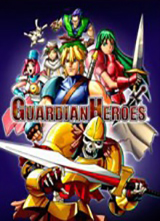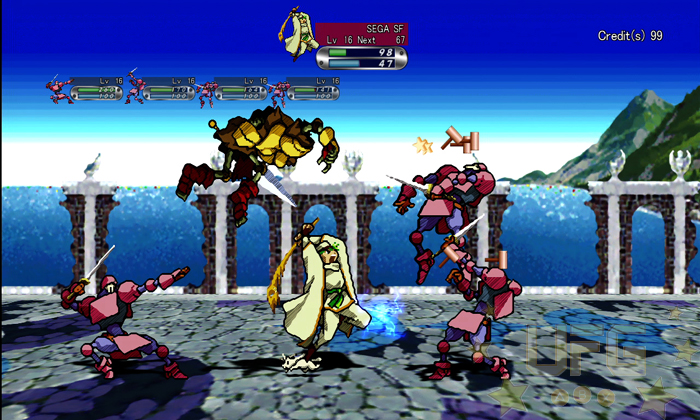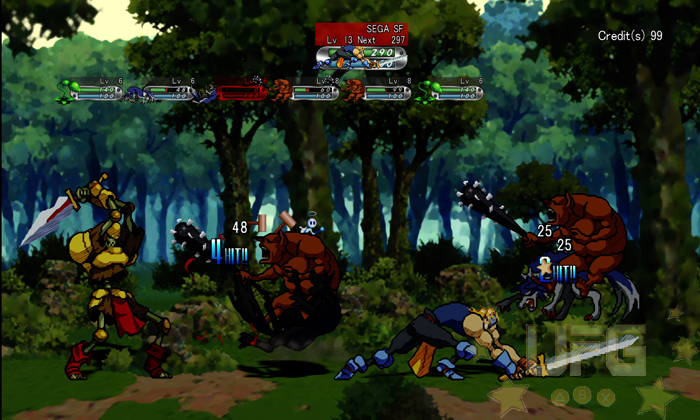Guardian Heroes (2011)
All of my friends know that I love a good Beat’em up game. Personally, I feel that Billy and Jimmy Lee could easily stand next to Mario and Luigi as legendary brothers of gaming! It’s such a shame that Beat ‘em ups only get made every once in a while; understandably, they’re not ranked high when it comes to sellable genres. Which is why whenever a developer decides to release (or re-release) a Beat’em up, I’m the first in line to check it out.
Such is the case with SEGA’s Guardian Heroes (GH). Now to be honest, I wasn’t big on this title when it released on the SEGA Saturn back in ‘96. While I did like GH I never played it enough to form a good opinion about it, which is why it doesn’t’ really make my Top Ten Beat’em up list. SEGA’s decision to re-release this title did me a solid because now I could experience the awesome gameplay that my friends were talking about back in the day.
Getting right to the gameplay, the people at Treasure (the original developers) were really trying to push the envelope with this title; it doesn’t play like your normal Beat’em up. This title is more akin to a fighting game. Each character has a list of moves that can be chained together to make devastating combos. There are the buttons controlling the kicks and punches/sword swipes that Beat’em up fans are used to, plus the ever popular power-move button. Each one performs a different attack depending on where the character is positioned and which directional buttons are being pressed. Take the character Ginjirou Ibushi, for example. He uses fast punches and kicks to take down enemies. Pressing Y by itself will cause him to throw rapid punches on the ground and fast kicks in the air. The combination of “down-down–Y” makes him do a spiraling upper cut that hits enemies multiple times (think Sagat from Street Fighter). If you press that same button combination while he is in the air he’ll do a diving kick, covering the ground with electricity when he lands. His moves range from throwing fireballs to causing lighting to rain down from the sky. Gamers are provided with a list of moves that is normally reserved for the Fighting genre. Enemies can be punched, kicked, thrown, juggled in the air, hit with fireballs, and frozen all during the same combo! What’s even cooler is that every character has their own unique moves (with maybe one or two copied from someone else).
There are other fighting game mechanics present in GH like blocking and countering attacks. You can even stun enemies; hit an enemy enough times and you’ll dizzy them, giving you a free opportunity to follow up with another onslaught of attacks. A cool mechanic is the ability to change planes within a stage. Normally in Beat ‘em ups, players would move their characters around the stage using the directional keys. If you needed to jump, you would use the jump button. In GH, pressing up on the d-pad will cause your character to jump. GH uses the bumpers to jump into the background and foreground. This really is a cool feature; it not only allows you to evade attackers (by switching planes) it also opens up for more abilities. Being that pressing up doesn’t move you to the background, the developer can use that “direction” in button combinations for additional special moves (pressing down, down, up, X for example). All of these elements contribute to a very robust fighting experience…in a Beat’em up.
Shifting focus a little bit, there are other interesting elements to the gameplay outside of the combat. The other elements are used in tandem of one another to deliver a fun, yet challenging experience. The first is the ability to level up your character. Causing damage to enemies will grant you experience points (you literally get xp per hit) that are used to upgrade different features ranging from how much health your character has to how fast they can attack. The second thing is the ability to choose what levels you want to tackle. It is similar to those Choose Your Own Adventure or Pick-a-path books; at certain parts of the story you are given a list of possible actions to take that will each lead you to a different level featuring different enemies and bosses. This also changes your affiliations to the different factions as well as what endings you get. The last thing is the fact that you don’t have unlimited credits/lives. That’s right; you actually have to work to beat this game. Who knew? Being able to pick what level you go to is cool, but you have to take into account that the enemies on higher levels are more dangerous then the lower ones. At the same time, they will give you more experience when killing them. You can level up your character but you can’t save it. If you run out of continues (game over), you’ll have to start back at level 1. This forces you to make choices as apposed to just going to the next stage like other titles in this genre. Therefore, giving this title a level of difficulty that seems to be lacking in other classic reboots (looking at you X-men Arcade)!
So far, I’ve pointed out everything that made the classic title awesome. For this re-release, SEGA wanted to bring GH into modern times by adding a few upgrades. Most are good; gamers can play online or locally, there is a new control scheme that adds a dodging and air dashing, the graphics can be ran in high def., and there is a new mode called Arcade (a survival mode). The added maneuverability is welcome as it gives players more options when battling tough opponents. The HD graphic upgrade is cool and I like the pencil-shade effect that was added to this version; you can swap between the original sprites and the newer ones. The Arcade mode provides a great challenge to seasoned brawlers. Being able to play online is awesome but the gameplay often suffers from lag. This makes it harder to counter moves or complete combos. While I did get a few games with no lag, they were far and few between. Not a deal breaker, the games were never unplayable and I still had fun. Then there is the VS mode. This mode (also in the original) allows gamers to pick almost any character in the game, bad or good, and battle each other in an arena. Originally it allowed for six players to compete at once. The new version allows up to twelve. With so many characters fighting on screen at once, the battles turn into a chaotic mess; I couldn’t even tell where my character was half the time. Again, not a deal breaker as you can lower the player count.
As it stands Guardian Heroes is an awesome Beat’em up that should be played, beaten, and then played again. There are little things that keep it from being all it can be. Those things shouldn’t keep you away though, and at the current price for admission ($10 or 800 MS points), it’s one of the best remakes around!
Gameplay:
8
Awesome combat and cool mechanics go a long way.
Graphics:
9
The hand drawn visuals fit this title well.
Sound:
8
Classic video game sounds.
What's New:
5
If we were reviewing the original title, this would have been a perfect score. As it stands, this new entry doesn’t add anything to the genre.
Replay Value:
10
There are multiple endings, characters, and bosses that can only be seen/unlocked with multiple playthroughs. Plus it’s fun!
Final Score:
8



